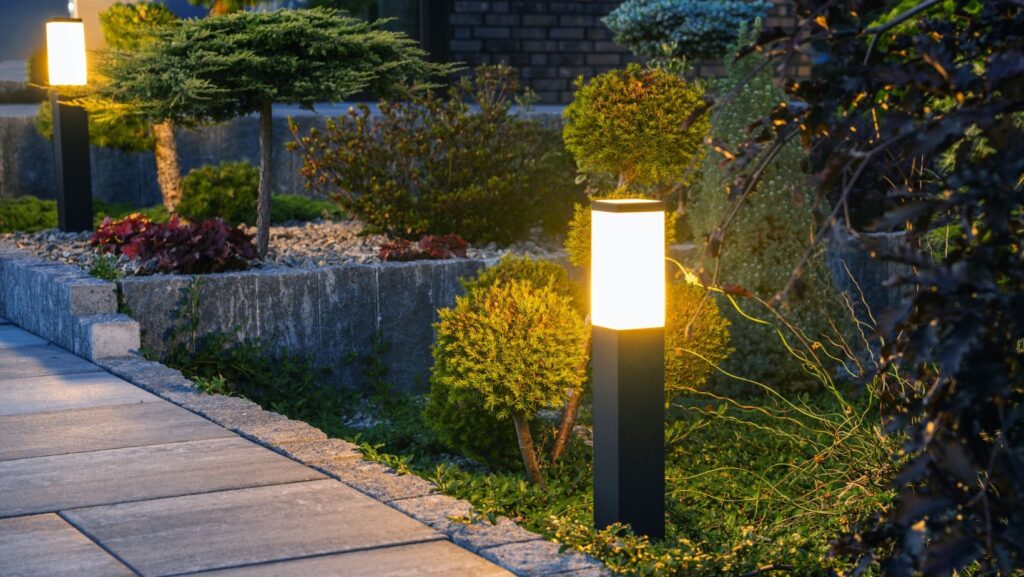Your outdoor space deserves the same attention as your indoor rooms. But creating a magazine-worthy patio or backyard doesn’t mean spending thousands on new furniture or landscaping. Small, thoughtful changes can completely transform how your outdoor areas look and feel. From adding string lights that create ambiance to updating forgotten details like hardware and textiles, these affordable ideas work for any budget. The trick is knowing where to spend and what changes deliver the most impact.
Even simple additions like designer outdoor lighting can turn a basic patio into an evening retreat that rivals any restaurant’s outdoor seating. These upgrades work whether you have a sprawling backyard or a tiny balcony.
Start with Lighting That Sets the Mood
Nothing changes outdoor spaces faster than good lighting. During the day, your yard looks fine. But at night? Without proper lighting, it becomes a dark, unusable void. The right lights extend your living space and create an atmosphere that makes people want to linger.
String lights remain popular for good reason. They’re cheap, easy to install, and instantly make any space feel festive. Hang them in straight lines for a clean look or swag them for a relaxed vibe. LED versions last longer and use less electricity. Choose warm white for a classic look or Edison bulbs for vintage charm.
Solar lights have gotten much better recently. No more dim, bluish glows that die after an hour. Today’s solar options provide real illumination all night long. Line pathways, highlight garden beds, or stake them around seating areas. They charge during the day and turn on automatically at dusk.
Don’t overlook candles and lanterns. Battery-powered LED candles give you a flickering ambiance without fire risk. Group different sizes on tables or steps for instant atmosphere.
Lanterns work hung from hooks or sat on surfaces. Mix metals and glass for a collected-over-time appeal.
Define Spaces with Outdoor Rugs
Outdoor rugs do what indoor rugs do – they define spaces and add comfort underfoot. They turn random furniture groupings into intentional conversation areas. They make concrete patios feel like outdoor rooms. And they’re much cheaper than installing new flooring.
Choose rugs made specifically for outdoor use. They resist fading, mold, and moisture. Polypropylene rugs clean easily with a hose and dry quickly. Natural fiber rugs like jute look great, but need covered areas to prevent rotting.
Size matters outside just like inside. Get rugs big enough that furniture sits on them, not around them. For dining areas, add at least 24 inches beyond your table so chairs stay on the rug when pulled out. Layer smaller rugs for added interest and to define different zones.
Colors and patterns hide dirt and wear better than solid light colors. But don’t be afraid of bold choices. Outdoor spaces can handle more dramatic patterns than indoor rooms. A bright geometric or oversized floral adds personality and draws the eye to your seating area.
Update Hardware and Fixtures for Instant Polish
Just like inside, outdoor hardware and fixtures make a bigger difference than you’d expect. Replace rusty gate latches, worn fence hardware, and basic house numbers with upgraded versions. These small metal elements add polish and show attention to detail.
Decorative wall outlet covers on exterior walls deserve the same attention as interior ones. Basic plastic covers look especially cheap against siding or brick. Weather-resistant metal covers in finishes that match your outdoor lights pull everything together. Some include built-in USB ports for charging phones during parties.
Don’t forget about your outdoor faucets and hose reels. Decorative hose pots hide ugly coils while adding style. Upgraded faucet handles in brass or black metal coordinate with other hardware. These functional elements become design features when chosen thoughtfully.
Replace cheap plastic address numbers with substantial metal or wood versions. Large, modern numbers make a statement and help delivery drivers find you. Backlit numbers add safety and style. Mount them on a piece of wood or directly on siding for different looks.
Add Comfort with Textiles and Cushions
Outdoor furniture often comes with thin, uncomfortable cushions or none at all. Adding or upgrading cushions transforms both comfort and style. Thick cushions make even basic furniture feel luxurious. They also give you chances to add color and pattern.
Buy cushions made for outdoor use with solution-dyed acrylic fabric. These resist fading and mildew while feeling soft like indoor fabric. Scotchguard regular cushions if you want more options. Store cushions in deck boxes or bring them inside during storms to extend their life.
Outdoor pillows add the same finishing touch they do inside. Mix sizes and patterns for interest. Use them to repeat colors from your garden or house exterior. Lumbar pillows make bench seating more comfortable. Floor cushions create extra seating for parties.
Don’t forget throws for cool evenings. Keep a basket of blankets near seating areas. Outdoor-safe throws in acrylic or polyester handle moisture better than cotton or wool. They make your space feel cozy and encourage people to stay outside longer.
Create Privacy with Plants and Screens
Privacy makes outdoor spaces feel like rooms instead of yards. You don’t need a fence to create separation. Strategic plants and screens define boundaries and block unwanted views without major construction.
Tall planters with bamboo or ornamental grasses create living walls. They move with breezes and soften hard edges. Wheeled planters let you reconfigure based on sun or party needs. Mix heights for natural-looking screens that don’t feel like barriers.
Outdoor curtains add softness and flexibility. Hang them from pergolas, between posts, or on freestanding frames. They block the sun, wind, and neighbors’ views while adding color and movement. Choose outdoor fabric that resists fading and mildew. Tie them back when you want openness.
Lattice panels and decorative screens provide instant architecture. They support climbing plants, hang string lights, and create backdrops for furniture groupings. Paint them to match or contrast with your house. Some fold for seasonal storage or party flexibility.
Upgrade Your Containers and Planters
Mismatched plastic pots make even healthy plants look sad. Coordinated containers pull your garden together and add style even when plants are small. You don’t need expensive ceramic or concrete planters. Spray paint transforms cheap plastic into sophisticated vessels.

Group containers in odd numbers for natural arrangements. Vary heights but repeat colors or materials for cohesion. Three black planters of different sizes look better than three identical ones. Use plant stands or stack pots to create height variations.
Self-watering planters reduce maintenance and keep plants healthy during hot spells. They cost more initially but save money on dead plants. Built-in water reservoirs mean less frequent watering and happier plants. They work especially well for vegetables and annuals.
Don’t limit containers to plants. Use them for storage, ice buckets during parties, or displays of garden tools. Large planters near doors hold umbrellas or sports equipment. Small ones corral citronella candles or outdoor dining supplies.
Simple Water Features for Sound and Movement
Water features seem expensive, but they don’t have to be. Tabletop fountains cost under fifty dollars and add soothing sounds that mask traffic noise. Solar versions need no outlets or complicated installation. Place them on side tables or garden walls.
Bird baths attract wildlife while adding classic garden charm. Modern versions in concrete or metal look sculptural even without birds. Change water frequently to prevent mosquitoes. Add a solar bubbler to create movement and sound while keeping water fresh.
For a bigger impact, try a container water garden. Any watertight pot becomes a mini pond with aquatic plants and maybe a small fountain. Mosquito dunks prevent bugs without harming plants. These portable water features work on patios, decks, or in gardens.
Final Touches That Make a Difference
Small additions complete your outdoor room’s transformation. Hang mirrors on fences or walls to reflect light and make spaces feel bigger. Outdoor clocks add function and style.
Thermometers and weather vanes become decorative elements that also serve purposes.
Garden art doesn’t mean tacky flamingos unless you want it to. Metal sculptures, colorful glass orbs, or interesting rocks add personality. Wind chimes and bells create sound gardens. Solar lights built into decorative stakes combine function with beauty.
Keep outdoor spaces tidy with attractive storage. Deck boxes hold cushions and toys while providing extra seating. Stylish hooks organize tools and hoses. Everything needs a place, just like inside. When storage looks good, you’re more likely to use it.
Frequently Asked Questions
Q: What’s the most budget-friendly way to light a large outdoor area?
A: Solar stake lights along pathways, combined with string lights overhead, give you the most coverage for the least money. Buy solar lights in bulk for better prices. String lights on poles or trees to avoid installation costs. Add battery-powered lanterns on tables for task lighting. This combination costs under $200 for most yards and requires no electrical work.
Q: How can I make cheap plastic furniture look expensive?
A: Spray paint specifically made for plastic transforms basic furniture. Clean thoroughly, sand lightly, and apply thin coats. Add thick cushions in quality outdoor fabric. Replace any visible hardware with metal versions. Group pieces thoughtfully rather than spreading them out. A can of paint and new cushions cost far less than new furniture but deliver dramatic results.
Q: What outdoor improvements add the most value when selling?
A: Clean, defined spaces with good lighting always impress buyers. Power wash everything first. Define seating areas with rugs and arrange furniture. Add string lights for evening showings. Fresh mulch and trimmed plants frame everything nicely. Simple improvements that show the space is usable and maintained matter more than expensive additions. Buyers want to envision themselves enjoying the space.
Q: How do I protect outdoor cushions and pillows from the weather?
A: Invest in covers or storage boxes to protect fabrics when not in use. Choose solution-dyed acrylic fabrics that resist fading and mildew. Spray regular fabrics with waterproofing treatment. Stand cushions on edge to dry after rain. Bring them inside during winter or extended bad weather. Good protection doubles the life of outdoor textiles.
Q: Can I use indoor accessories outside temporarily?
A: Yes, for parties or photos, but bring them in afterward. Indoor rugs work for one-day events if the weather is dry. Regular pillows are fine for a few hours. Indoor lamps should never go outside unless specifically rated for it. Metal and glass accessories handle temporary outdoor use better than fabric or paper. Always check weather forecasts before risking indoor items outside.

